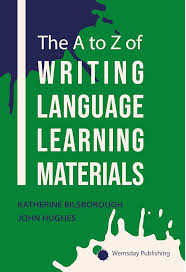Writing Materials for Business English
John Hughes is a teacher trainer and author. With over 100 ELT titles, his Business English books include the Business Result series, Successful Meetings and Successful Presentations (Oxford University Press), Success with Business (National Geographic Learning), and ETpedia Business English (Pavilion ELT). He currently runs an online course in materials writing for teachers at www.writingeltmaterials.com. He has also written on a range of other subjects including theatre, sustainability and travel. Email: john@hugheselt.com

Preconceptions
Teachers and materials writers often believe there is a big difference between materials for general English and those for business English. It’s true that there are differences but there are also similarities. Let’s consider some of these.
Language
As with general English (GE), materials that teach language are still fundamental in business English (BE) materials. BE materials writers have to find texts, use videos, write grammar explanations, write vocabulary gapfills and create speaking activities. However, for business English, the emphasis shifts towards language for a specific purpose and effectiveness. There is less importance placed on the accurate reproduction of grammar, for example, and more on achieving a real-world outcome.
Level
The issue of level is particularly interesting for writers. In GE, a term like 'supply chain' is probably CEFR level C1 to C2 but in BE writing, it's very frequent, so you could introduce it to A2-level BE learners if their job involved referring to a supply chain. In other words, in BE, the learner’s need for specific language takes precedence over learning a set of GE vocabulary at prescribed language levels.
Talk about professional knowledge
In GE coursebooks, the titles of units are typically topics like sport, weather, and transport. With BE, topics are more likely to be areas like marketing, management and human resources. They provide the context for the unit and the language so that students can discuss these topics in English. That doesn't mean BE learners don't also need (and want) to talk about general topics, just that the writers might devote less space to them.
Effectiveness over accuracy
In addition to talking about business topics, students need to do business in English, so many BE publications emphasise speaking tasks in the form of tasks, role plays, discussion points and sometimes case studies. BE materials tend to be functionally and lexically driven rather than grammar driven because – as mentioned earlier – the focus is on effectively achieving an outcome rather than getting every language item right.
Future-ready with career skills
Increasingly, BE materials include a focus on softer skills development such as coaching, empathy or problem-solving. These skills are in demand by employers and often identified as lacking in potential employees. There is now pressure on universities and their graduates to develop these skills before they enter the careers market, so BE materials writers have a role to play here.
Format for the materials
How all this written content is delivered in the BE context is a question that also affects all of us in GE. For many years people have doubted the suitability of the printed coursebook in the BE context, and yet sales of printed BE coursebooks remain steady. In addition, businesses have greater access to the latest technology so BE materials writers need to produce content that will work on a laptop or a phone screen.
An iterative process
Finally, if you are BE teacher (or trainer), you probably already create materials for many of your learners based on their specific needs. More than for GE materials, BE materials writing can be quite an iterative process. You try to find out your learners’ needs and then create materials which respond to those needs. Inevitably, though, those needs can change – sometimes overnight! For example, your learners might suddenly find out they have to give a presentation in a few days, so instead of using pre-prepared materials with a focus on, say, negotiating, you might decide to create something that covers language for presentations. As such, the process of BE materials writing is often one of prototyping, testing, tweaking and repeating.
The above article is taken from ‘The A to Z of Writing Language Learning Materials’ by John Hughes and Katherine Bilsborough (Wemsday Publishing). It appears in the book as ‘B is for Business English’. Full details of the A to Z can be found at https://writingeltmaterials.com/book/

Find out more
You may wish to watch the following video in which John Hughes is talking about teaching business English or rather, what he calls, work English.


Coming soon! Please check the Pilgrims in Segovia Teacher Training courses 2026 at Pilgrims website.
Teaching Business English: Paths and Possibilities
Jelena Perišić, Serbia50 Ways to Teach Business English, Tips for ESL/EFL Teachers
Marjorie Rosenberg, AustriaFluency Activities for Small Talk in Business English
John Hughes, UKWriting Materials for Business English
John Hughes, UK10 ideas from ETpedia Business English from Pavilion
One-to-One: An Updated and Practical Guide to Teaching. A New Addition to Your CPD Collection
review by Oksana Hera, UkraineBusiness Impact. Business English Modules from DELTA Publishing, with a Short Review, by Hanna Kryszewska, Poland
Hanna Kryszewska, PolandA Golden Classic: Tree Swing Cartoons
Hanna Kryszewska, Poland